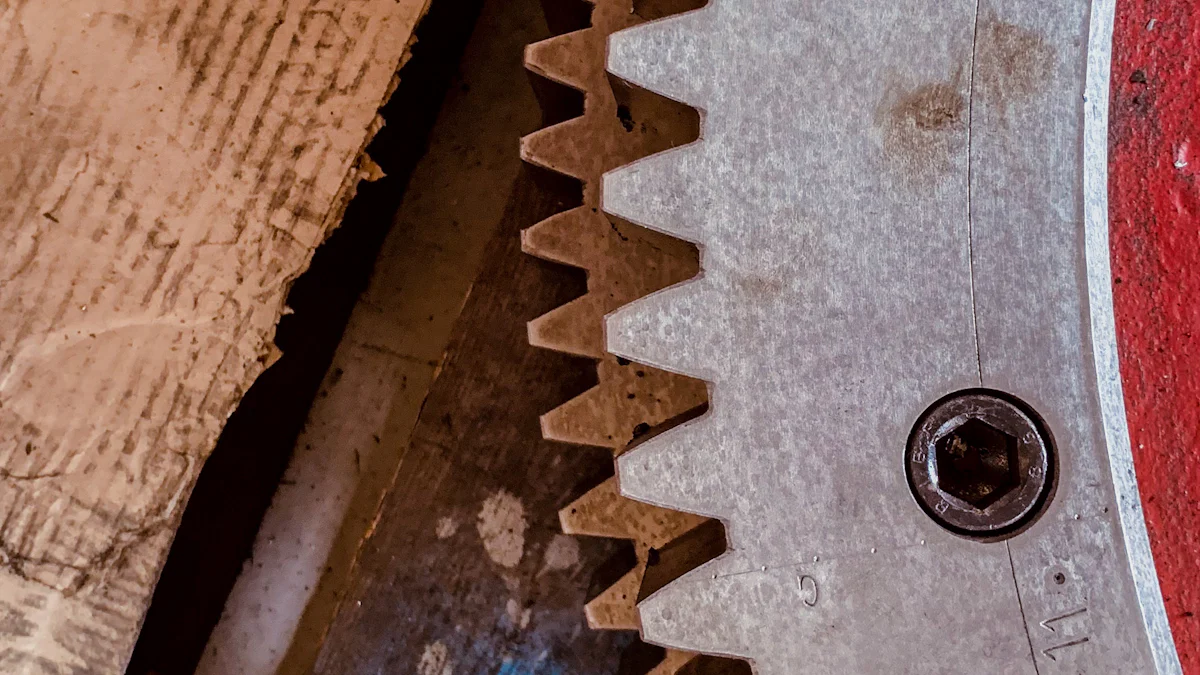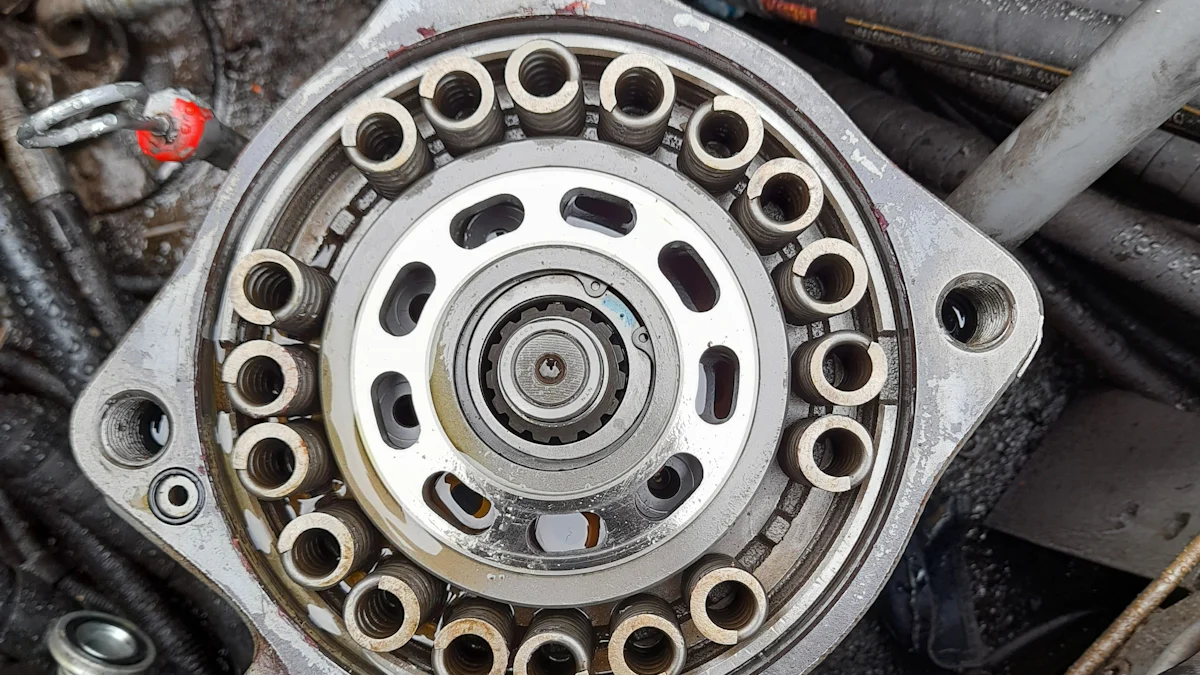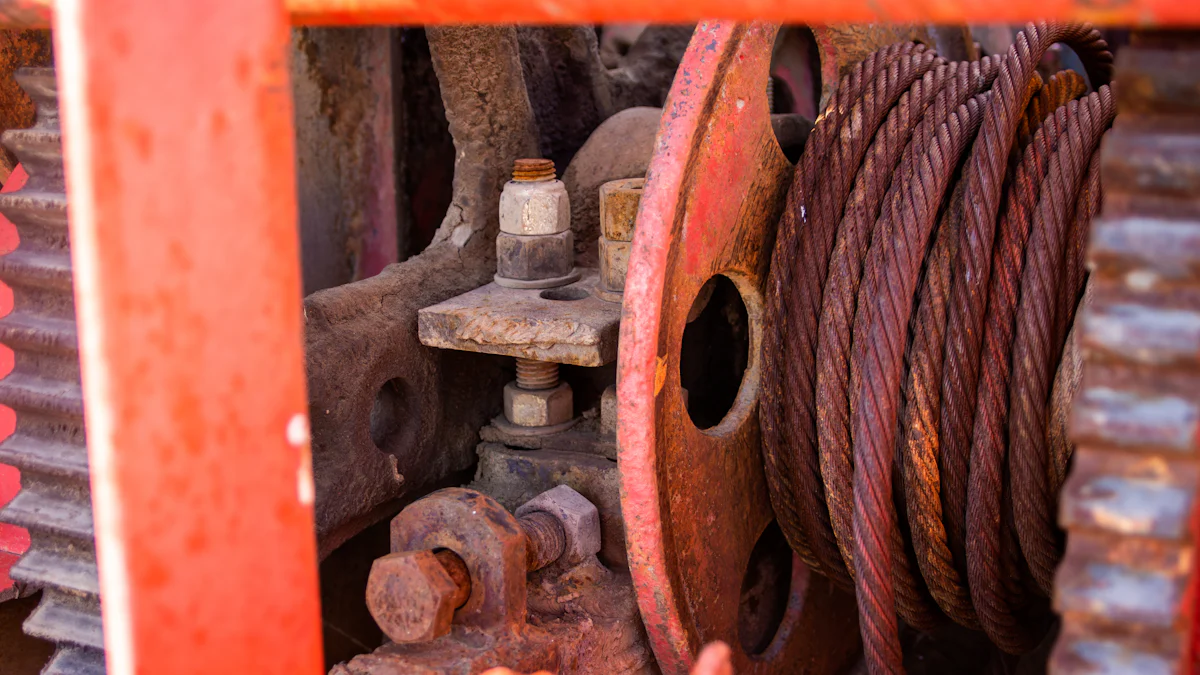What are Hydraulic Slewing Drives

Hydraulic slewing drives are compact gearboxes that use hydraulic systems to create rotational movement. You can rely on them to handle axial, radial, and tilting loads in demanding environments. Models like the IWYHG Series Slewing, IYH Series Slewing, and IYHG Series Slewing offer reliable solutions for heavy-duty applications, ensuring smooth and efficient operations.
Key Takeaways
- Hydraulic slewing drives help with turning and carrying heavy loads. They are important in industries like building and renewable energy.
- Taking care of them with checks and oiling keeps them working well and lasting longer.
- Choosing the right one means checking load and force needs, thinking about the environment, and using the right hydraulic oil.
Components of Hydraulic Slewing Drives

Slewing Ring and Bearings
The slewing ring forms the core of a hydraulic slewing drive. It allows rotational movement while supporting heavy loads. Bearings inside the slewing ring reduce friction and ensure smooth operation. You’ll find these components essential for handling axial, radial, and tilting forces. The durability of the slewing ring and bearings directly impacts the performance of your hydraulic slewing system. Regular inspection helps you maintain their efficiency and extend their lifespan.
Hydraulic Motor and Brake
The hydraulic motor powers the slewing drive by converting hydraulic energy into mechanical motion. This motor provides the torque needed for rotation. A brake system works alongside the motor to control movement and hold the position when required. You can rely on the hydraulic motor and brake to deliver precise and reliable performance, even under heavy loads. Proper maintenance of these parts ensures consistent operation and prevents unexpected downtime.
Housing, Seals, and Gears
The housing protects internal components from external damage and contamination. Seals prevent hydraulic fluid leaks and keep dirt or debris out of the system. Gears inside the housing transfer torque from the motor to the slewing ring. These components work together to ensure the hydraulic slewing drive operates efficiently. You should regularly check the seals and gears for wear to avoid performance issues.
How Hydraulic Slewing Drives Work
Hydraulic Power Transmission
Hydraulic slewing drives rely on hydraulic power to create rotational movement. The hydraulic motor converts pressurized fluid into mechanical energy. This energy drives the gears, which then rotate the slewing ring. You can control the speed and direction of rotation by adjusting the hydraulic flow. This system ensures smooth and precise motion, even under heavy loads. Hydraulic power transmission also allows for efficient energy use, making it ideal for demanding applications.
Torque and Load Management
Torque plays a critical role in the performance of hydraulic slewing drives. The system generates high torque to handle heavy axial, radial, and tilting loads. You can rely on the hydraulic motor to deliver consistent torque, ensuring stable operation. The gears inside the drive distribute the load evenly across the slewing ring. This design minimizes wear and extends the lifespan of the components. Proper torque management helps you maintain efficiency and prevent mechanical failures.
Integration with Machinery Systems
Hydraulic slewing drives integrate seamlessly with various machinery systems. You’ll find them in cranes, excavators, and wind turbines, where precise rotation is essential. The compact design makes it easy to install the drive in tight spaces. Hydraulic controls allow you to synchronize the slewing drive with other machine functions. This integration enhances the overall performance and versatility of your equipment. By choosing the right hydraulic slewing drive, you can optimize your machinery for specific tasks.
Applications of Hydraulic Slewing Drives

Construction and Heavy Equipment
You’ll find hydraulic slewing drives essential in construction and heavy equipment. They enable precise rotation in cranes, excavators, and aerial work platforms. These drives handle heavy loads while maintaining stability and control. For example, in tower cranes, they allow smooth rotation of the jib, ensuring accurate material placement. Their compact design makes them easy to integrate into machinery, even in tight spaces. By using hydraulic slewing drives, you can improve the efficiency and safety of your construction operations.
Renewable Energy Systems
Hydraulic slewing drives play a critical role in renewable energy systems. In wind turbines, they control the yaw mechanism, which adjusts the turbine’s direction to capture maximum wind energy. This ensures optimal power generation. You can also use them in solar tracking systems to rotate solar panels, following the sun’s movement throughout the day. Their ability to handle high torque and operate in harsh environments makes them ideal for renewable energy applications. With hydraulic slewing drives, you can enhance the performance and reliability of your energy systems.
Mining and Marine Industries
In mining and marine industries, hydraulic slewing drives provide reliable performance under extreme conditions. You’ll see them in mining excavators, where they enable the rotation of heavy buckets for material handling. In marine applications, they are used in ship cranes and offshore platforms to manage heavy loads and ensure precise positioning. Their durability and resistance to corrosion make them suitable for these demanding environments. By incorporating hydraulic slewing drives, you can achieve efficient and dependable operations in these industries.
Selecting the Right Hydraulic Slewing Drive
Load and Torque Considerations
When choosing a hydraulic slewing drive, you must evaluate the load and torque requirements of your application. Start by determining the maximum axial, radial, and tilting loads the system will encounter. These factors directly influence the size and capacity of the slewing drive you need. Torque is equally important. A higher torque rating ensures the drive can handle heavy loads without compromising performance. Always select a drive with a torque capacity that exceeds your operational demands. This approach provides a safety margin and prevents mechanical failures during peak loads.
Environmental and Operating Conditions
The environment where you plan to use the hydraulic slewing drive plays a critical role in its selection. Consider factors like temperature, humidity, and exposure to dust or corrosive elements. For outdoor applications, choose a drive with weather-resistant seals and corrosion-resistant materials. If the system operates in extreme temperatures, ensure it can maintain performance under those conditions. By matching the drive’s specifications to the operating environment, you can enhance its durability and reliability.
Hydraulic Oil and Compatibility
Hydraulic oil compatibility is another key factor. The type of hydraulic oil you use affects the drive’s efficiency and longevity. Check the manufacturer’s recommendations for oil viscosity and quality. Using the wrong oil can lead to poor performance or damage to internal components. Regularly monitor the oil’s condition and replace it as needed. Proper oil selection and maintenance ensure the hydraulic slewing drive operates smoothly and efficiently over time.
Maintaining Hydraulic Slewing Drives
Inspection and Lubrication Practices
Regular inspection keeps your hydraulic slewing drive in top condition. Check for signs of wear, such as cracks or unusual noises, during operation. Pay close attention to the slewing ring and bearings, as these components handle the most stress. Lubrication is equally important. Apply the recommended grease to reduce friction and prevent overheating. Follow the manufacturer’s guidelines for lubrication intervals. Over-lubricating can cause leaks, while under-lubricating leads to premature wear. By staying consistent with inspections and lubrication, you can extend the lifespan of your equipment.
Monitoring Hydraulic Oil Quality
Hydraulic oil plays a vital role in the performance of your hydraulic slewing system. Contaminated or degraded oil reduces efficiency and damages internal components. Check the oil’s color and viscosity regularly. Dark or thick oil indicates contamination or aging. Use a clean container to collect a sample and compare it to the manufacturer’s standards. Replace the oil if it doesn’t meet the required specifications. Always use the recommended type of hydraulic oil to ensure compatibility. Proper oil monitoring helps you maintain smooth and reliable operations.
Replacing Components and Preventing Overload
Worn-out components can compromise the performance of your hydraulic slewing drive. Replace damaged seals, gears, or bearings as soon as you notice issues. Delaying repairs increases the risk of system failure. Preventing overload is another critical step. Avoid exceeding the drive’s load and torque limits. Overloading causes excessive wear and shortens the lifespan of the system. Use load-monitoring tools to ensure safe operation. By replacing faulty parts and managing loads effectively, you can keep your hydraulic slewing drive running efficiently.
Hydraulic slewing drives play a vital role in industrial applications. They provide reliable rotation and load management for heavy-duty tasks. Selecting the right drive ensures efficiency and safety. Regular maintenance, including inspections and lubrication, extends its lifespan. By prioritizing proper care, you maximize performance and reduce downtime in your operations.
FAQ
What are the benefits of using hydraulic slewing drives?
Hydraulic slewing drives offer high torque, precise rotation, and durability. You can rely on them for heavy-duty applications in harsh environments, ensuring efficiency and reliability.
How do you maintain a hydraulic slewing drive?
Inspect components regularly, lubricate bearings, and monitor hydraulic oil quality. Replace worn parts promptly to prevent failures and extend the system’s lifespan.
Can hydraulic slewing drives handle extreme conditions?
Yes, they perform well in extreme temperatures, high loads, and corrosive environments. Choose models with weather-resistant seals and materials for optimal durability in challenging conditions.